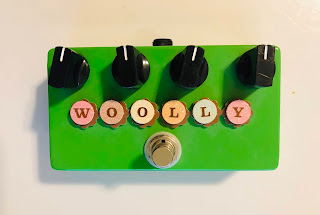I used pre-bonded 24AWG wire from Smallbear in my earliest projects, which I prefer over the stranded wire from Mammoth and Tayda that I now use. The parts used were mostly from Tayda Electronics, except for the electrolytic capacitors I salvaged a component kit from my sophomore year electronics class.
Guts of the Triangle Big Muff Clone
Old video of my pedal through a Vox Pathfinder amp
Pedal through Fender Pro Junior IV
I started to put together fuzzes/overdrives on veroboard after discovering the Tagboard Effects and SabroTone blogs. I discovered Mammoth Electronics as a source of 125B-sized inexpensive enclosures. Two of the pedals I am currently playing again are the Meathead and Woolly Mammoth fuzzes.
Meathead Clone with switchable input/output coupling capacitors
Guts of Meathead Clone
Video of Input Capacitor Effect in Meathead
The effect of the large values that I chose for the output caps were inaudible. I may switch out for smaller caps in the pF and low nF range, as shown in the alternate layout on the Tagboard Effects post. The effect of changing the input cap is most prominent when using the bridge pickup for me. The 43nF setting is much more audibly different to the 10nF setting than the 20nF setting in terms of bass response.
I tend to keep the Dirt knob low, because my build turned out to be noisy past 12:00. It is also much past unity gain at that point.
Woolly Mammoth clone
Guts of Woolly Mammoth Clone





No comments:
Post a Comment